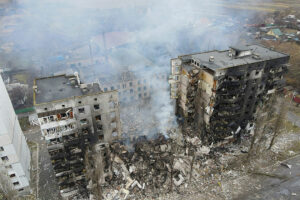More retailers seen to occupy transit-oriented spaces

COLLIERS Philippines said it expects an increase in retailers occupying transit-oriented retail spaces due to the rise in public transport infrastructure projects.
“A lot of retailers (will) occupy mall spaces within the transit-oriented retail spaces,” Colliers Philippines Associate Director Joey Roi H. Bondoc said during a press briefing last week.
“You have all these infrastructure projects that will be completed between 2024 to 2029,” he added.
Mr. Bondoc cited One Ayala, launched in 2022, which is directly linked to the Manila Metro Rail Transit System (MRT)-3.
Similarly, the Araneta City Terminal is situated near residential and office towers as well as the MRT-3, Light-Rail Transit 2, and the Araneta City Bus Terminal.
The viability of transit-oriented development provides a lot of optimism for developers as infrastructure projects ensure high consumer traffic and spending from commuters, he said.
Under the revamped Build Better More program, Mr. Bondoc noted that it is fitting for retailers to lease out brick-and-mortar spaces within the infrastructure projects expected to be completed between 2024 and 2029.
“Looking at Ninoy Aquino International Airport (NAIA), which will be expanded, modernized, capacity of 32 million, New Manila International Airport in Bulacan, 35 million, MRT 7, MRT 3, capacities of 350,000, 800,000 for the North-South Commuter Railway,” he said.
Among these is the 36-kilometer Metro Manila Subway which is seen to provide 520,000 capacity that spans from Quezon City to NAIA in Pasay.
Colliers also reported developers renovating their retail spaces, such as Uniqlo in SM Mall of Asia, Timezone in Trinoma, Shangri-La Plaza Mall in Puma, Bayo in Glorietta and more.
Additionally, food and beverage (F&B) and fast fashion retailers continue to lead retail space uptake as they occupy a significant portion of the available physical retail space in the market.
About 43% of upcoming retailers in the first quarter are attributed to F&B, followed by 35% for fashion, beauty, and health, with technology accounting for 6%.
Mr. Bondoc said that Ayala Land has earmarked P13 billion for the redevelopment of its malls, with most projects expected to be completed by 2026, including Glorietta, Ayala Center Cebu, Trinoma, and Greenbelt 2.
Colliers forecasts the vacancy rate to decline to 17% by the end of 2024, driven by the annual completion of retail space totaling 162,300 square meters over the three years from 2024 to 2026.
Selected upcoming projects between 2024 and 2027 include Bridgetowne Opus Mall in Quezon City, the expansion of SM Mall of Asia in the Bay Area, and Ayala Mall Arca South.
Makati has Greenbelt 1 and 2 redevelopments.
Meanwhile, the vacancy rate rose to 15.5% for the first quarter of 2024, which is the industry average for the Metro Manila sector. This is higher than the 14.4% recorded quarter on quarter, attributed to new mall openings.
INCOMING STOCK TO INCH UP VACANCY LEVELIn a similar trend, incoming office stock will marginally increase the vacancy level to 19.6% by 2024 from 19.3% last year.
“We expect vacancy to remain below 20%, marginally increasing to 19.6% by the end of the year, since we are still expecting over half a million of the office space will be expunged from the line this year,” Kevin Jara said.
Colliers reported a 19% vacancy rate for the first quarter of 2024 or about 2.7 million square meters (sq.m.) of vacant spaces.
Mr. Jara said vacancy remains flat and inched from 19.3% in the last quarter.
“We’re expecting 553,000 sq.m. to be completed this year and that number will taper to 300,000 sq.m. to 400,000 sq.m. annually until 2027 as we still see the developers rationalizing their office pipeline,” he said.
Colliers expects the office stock to reach 365,000 sq.m. in 2025, 463,000 sq.m. in 2026, and 405,000 sq.m. in 2027.
About 63% of new buildings in the next four years will be Grade A.
Quezon City’s stock is seen to last with 67,000 sq.m. in 2027. Bay Area, Quezon City, and Makati Fringe are expected to contribute half of the new supply this year.
The vacated spaces also rose 37% to 161,000 sq.m. in the first quarter of 2023.
In terms of net take-up, the consultancy firm is expecting it to reach 366,000 sq.m. by the end year of 2024.
Year on year, Mr. Jara said the office space transaction rose 88% to 240,000 sq.m. in the first quarter of 2024 from 128,000 sq.m. in the first quarter of 2023.
However, this is 27% lower than the previous 331,000 transactions in the fourth quarter of 2023.
Traditional firms led the most office deals in the first quarter with 107,000 sq.m. and accounted for a 44% share in the overall transactions, according to Mr. Jara.
This was followed by business process outsourcing companies at 75,000 sq.m. (31%), Philippine Offshore Gaming Operators (POGO) at 54,000 sq.m. (23%), and shared services at 4,000 sq.m. (2%).
“We’ve also monitored some POGO transactions, mostly concentrated in the Bay Area at 54,000 and largely concentrated in just very few deals,” he said.
Bay Area logged the most transaction activity in Metro Manila with 99,100 sq.m. About 35,000 sq.m. of these are from government offices.
In addition, Fort Bonifacio came second at 30,000 sq.m. and Quezon City at 25,000 sq.m. — Aubrey Rose A. Inosante




